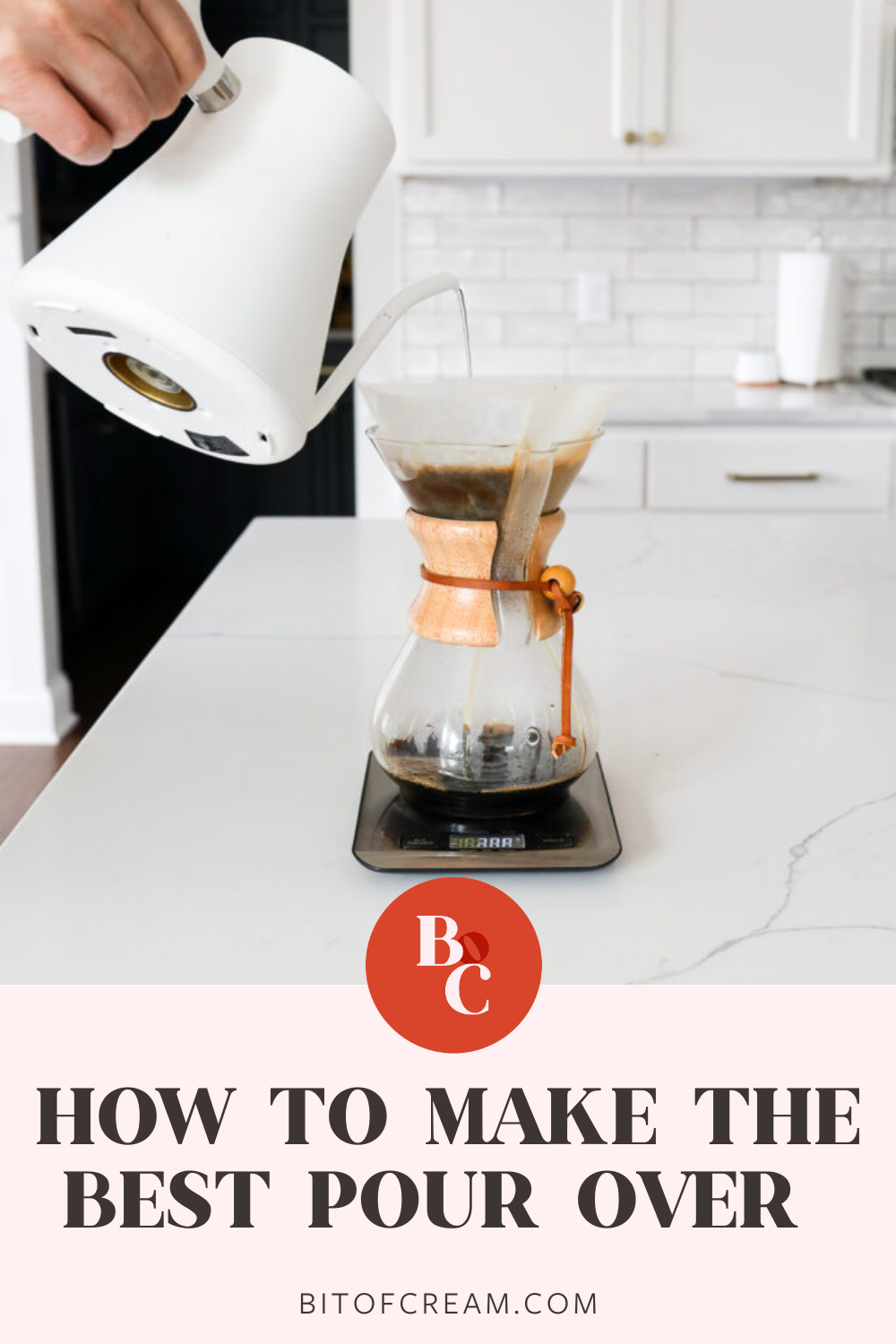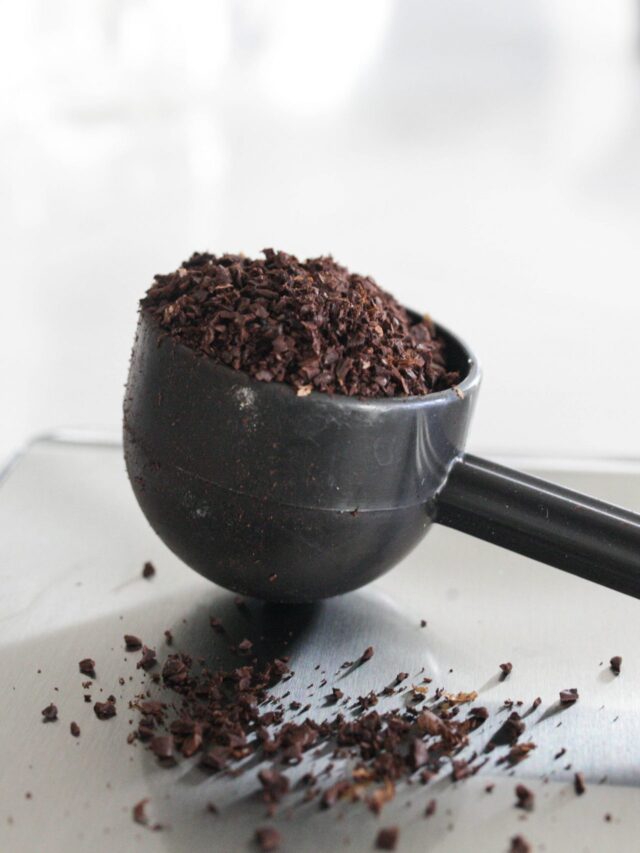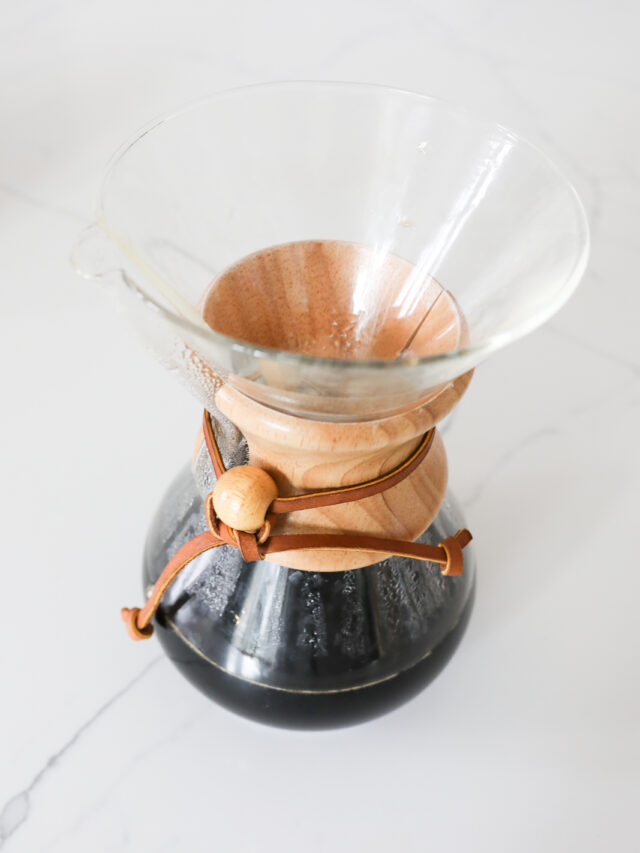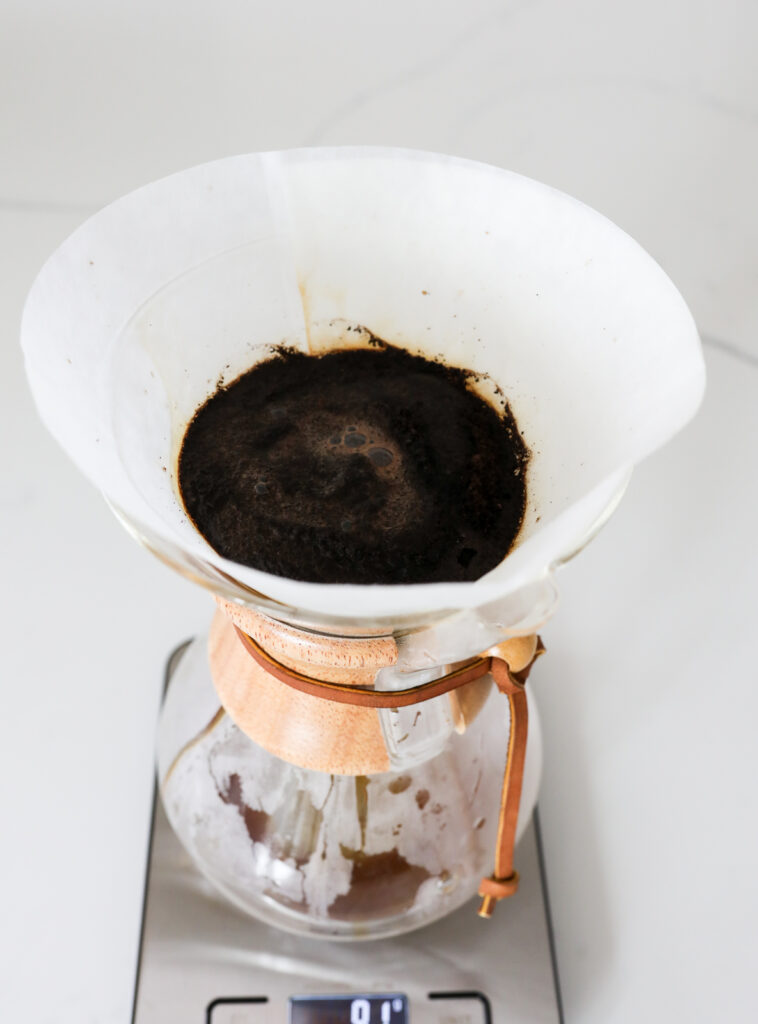It’s easy to make a bad pour over coffee. Most people do.
Without a proper ratio, or the right tools, you’ll wind up throwing away perfectly good coffee. Or using a delicious creamer to mask the bitterness of poor extraction.
Fortunately, learning a few simple steps will allow you to brew pour over better than 95% of people out there.
In this article, I’ll explain exactly what you need to nail the perfect coffee ratio so you can stop guessing, and make an excellent pour over every time!
Water To Coffee Ratio
You’ll always get a better result by using a digital scale to measure your coffee by weight.
This simple step ensures that you’ll get a consistent ratio every time. It also reduces the likelihood that you’ll over or under-extract your pour-over.
The table below illustrates adjustments to common pour over ratios, measured by weight in grams.
| Coffee (Grams) | Water (1:15) | Water (1:16) | Water (1:17) |
| 18 | 270 | 288 | 306 |
| 21 | 315 | 336 | 357 |
| 24 | 360 | 384 | 408 |
I always recommend starting your pour over with a 1:17 ratio. You can always adjust if you want the flavor to be stronger after the first cup.
Use the chart above for reference, or employ the ratio for simple napkin math.
For example, suppose you have 35 grams of ground coffee. To brew at a 1:17 ratio, you would need 17x that weight of water. 595 grams, or about 3-4 cups of coffee.
What if you don’t have a scale?
Though it’s less consistent, you can measure your coffee by tablespoon. I would only recommend doing it this way if you simply can’t weigh it, or use our handy guide that breaks down exactly how much coffee you need per cup.

Water Temperature
Brew your filtered water to 205 F.
Don’t forget the importance of using the correct type of water in order to get the best cup of coffee each time.
Using an electric kettle, you can set the temperature of the water for each batch. It will begin to cool as soon as you take the kettle off its base, but that’s okay. If you start at 205 F, the water will remain in a safe range for brewing.

You can also use a stovetop kettle with a built-in thermometer, but you’ll have to watch the kettle so it doesn’t overheat.
You might use a timer to pinpoint when the water reaches a certain temperature on your stovetop. Then you won’t have to stand by watching the thermometer gauge. While the kettle warms up, set up the rest of your pour over station.
If water takes too long to pass through the amount of coffee in the filter, there is a risk of over-extraction. This can occur when the grind is too fine. Over-extracted coffee often tastes ashy or burnt.
Grind Size
Grind size is closely coupled with timing, which is essential for proper extraction.
If the water passes through too fast, the risk is under-extraction. This happens when the grind is too coarse. Under-extracted coffee is usually marked by a salty or medicinal flavor.

Origin & Roast Level
Any coffee will do in a pour over, and different pour over methods will highlight different flavors of the same coffee beans.
A classic Melitta pour over will do the trick if you’re working with rich, heavy-bodied coffee. The fruity citrus notes of medium-light roasts are well highlighted in a Chemex, Kalita, or V60.
My advice is to start with beans you love and use the pour over method that will bring out its best qualities, or you can always take a deep dive into our 5 favorite types of beans for pour overs.

If you’re using lighter roast coffees, you might need more water to extract all the good flavor. Try increasing the ratio of water slightly to experiment.
If you’re on the fence on which light roasts to try first, check out our light roast coffee guide that features some of our favorites!
If you’re working with dark roast, less water is often the better place to start. Because so much flavor is extracted in the roasting process, dark roast doesn’t need as much water to release it.
Brew Time
Brew time will vary depending on the device you use and how much coffee you are brewing. As a general rule, for the best results, aim for 3-4 minutes total, including your 30-second bloom.
Say you’re brewing 400 grams of coffee. I like using a progression that includes a bloom and 3 other “pulses” of water,
- Bloom with 30 grams of water for 35 seconds.
- Divide your remaining water, 370 grams, into three pours. That way the coffee has plenty of time to drain within the 4-minute range.
Always start your stopwatch at the same time you begin pouring to track your progress in order to get the best coffee.
Equipment

- Gooseneck Kettle: A home barista’s best friend, the gooseneck kettle restricts the flow of the water in its narrow spout and is a good starting point for those who are just starting their pour over journey. This allows you to control how much water you pour at a time. Electric gooseneck kettles also come with temperature controls so you can maintain proper brew temperature throughout the entire process. If you’re on the fence about which gooseneck kettle is right for you, check out our complete guide on best electric kettles that are perfect for pour over coffee.
- Digital Scale: A digital scale provides the best method for measuring coffee. Placing the pour over on top of the scale as you brew ensures you’re pouring an accurate amount of water each time. When shopping for a digital scale, you can become overwhelmed with all of the options out there, that’s why we’ve uncovered 5 of the best coffee scales on the market.
- Burr Grinder: Burr grinders are the absolute best way to grind coffee. They ensure a uniform grind consistency so you don’t wind up with a poorly extracted final cup of coffee. If you’re looking for the perfect Burr grinder that suites your kitchen and budget, check out our full Burr grinder guide that gives pros and cons of each model. Or if you’re on a budget we’ve listed some of our favorite cost-effective grinders here.
- Pour Over Device: It depends on personal preference, but if you’re particular about your coffee and you want to use medium-light roasts, I recommend a Chemex, V60 or Kalita. If you tend to stick to darker roasts, the Melitta is a great option that makes a perfect cup of coffee. And if you want to skip the manual process and skip straight to an automatic pour over, check out these 5 incredible automatic pour over coffee makers.
How To Make Pour Over Coffee
Pour over coffee is a delicate yet straightforward brewing process that creates delicious coffee.
After you grind your coffee, wet your paper filter and dump the water.
This heats up your vessel and cleanses any paper flavor from the filter at the same time.

Then add your coffee and shake it so the coffee bed is nice and flat. Pour hot water in a circular motion. Returning to the middle of the bed, reverse that same motion towards the middle and repeat.
Here is a time-based breakdown of the process as well as the golden ratio for the best pour:
1:17 ratio, 24 grams of coffee, 418 grams of water
- 0:00 Bloom the coffee bed with 30 grams of water to let the grounds degas.
- 0:35 In a slow, circular spiral, add the first 129 grams of coffee to a total of 159 grams.
- 1:00 Add another 129 grams to a total of 288.
- 2:20 Continuing the same steady stream motion, add the rest of the water until you reach 418 grams of water. Let it drain, with a total brew time between 3:30 and 4:00 minutes total.
Enjoy your perfect cup of coffee! If you’re still wondering what the difference is between a pour over vs. french press, head here to our complete coffee comparison guide.
Or if you’re still thinking you might be a drip coffee fan instead, check out the difference between pour over vs. drip coffee comparison guide here!
FAQ
Yes. Wetting the filter reduces the likelihood of paper flavor in your coffee and heats the vessel or mug you are brewing into. This is a nice touch because it means your fresh coffee won’t immediately land in a cold mug. Some people do not wet the filter, but I prefer to brew on the safe side. I also like my coffee to stay hot for longer; a warm mug helps.
You should always bloom the coffee grounds at the start of the pour over process. Some experts disagree on how long the bloom should last, but an average bloom is 30 seconds. This allows the coffee grounds to degas and release carbon dioxide before brewing. The bloom enhances the flavor of the coffee.
If you consider 8 ounces to be a golden cup standard size, then 18 grams of ground coffee will suffice. But if you prefer to start the day with a 16-ounce cup of coffee, you might start with 24 grams of ground coffee instead.
